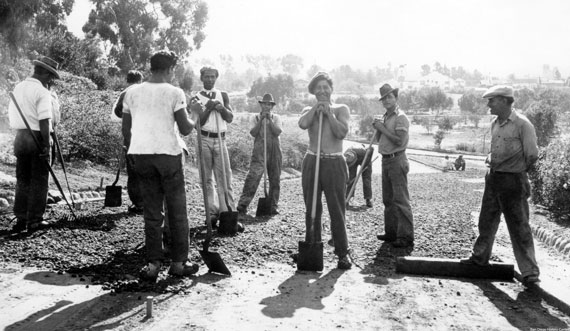|
A Historical Perspective of Horticultural Development
The landscape that can be seen today in and around Presidio bears no resemblance to the land as the indigenous peoples saw it, save topography, and in some case not even the height and shapes of the hills are the same. San Diego's coastal landscape varies naturally, by location. San Diego is riddled with micro-climates and micro-ecosystems. Historically, Presidio Park would have been populated with low shrubs, possibly an oak or two and perhaps some cactus. The ground was very rocky and in some areas very steep.
When Father Junípero Serra arrived in 1769 establishing the Presidio just to the west of and downhill from the modern day Serra Museum, working the rocky ground was difficult. On the precipice of this hill and adjacent areas he likely would have encountered rhus integrifolia (lemonade berry), opuntia littoralis (prickly pear), heteromeles arbutifolia (toyon) perhaps eriogonum fasciculatum (California buckwheat) and maybe an occasional quercus agrifolia (coastal live oak).
This should be considered a generalization as there were certainly other native plants that would have been encountered by Father Serra. For example, the riparian environment in the nearby river bed would be flourishing with other species, oaks, sycamores, etc., but on the "Hill" these five species serve as a good starting point for understanding what existed before the California horticultural explosion of the 1880s and onward.
|
 WPA workers at Presidio Park, 1937. Photo courtesy San Diego History Center |
After the abandonment of the Presidio during the 1830s little to nothing was done on the "Hill." It was all but forgotten—all but forgotten until George Marston seized the opportunity to preserve one of San Diego's greatest historical treasures. By the early 1930s George Marston had purchased most of the privately held plots that now make up Presidio Park and had financed the development of the park, including building the Serra Museum, grazing the roads, installing irrigation, and the planting of plants.
In the late 1920s George Marston hired Percy Broell as park superintendent, who held that position for ten years and was instrumental in the development of Presidio Park. And in 1937, he produced eight maps with botanical legends documenting what he had planted and what was present in the park at that time. And thus began Presidio Park's horticultural experiment. That document remains unpublished. The maps he produced are unknown, until now.
George Marston's efforts are the reason Presidio Park exists today. Because of his philanthropy there is a
Serra Museum, there exist roads, there are irrigation lines, there were personnel hired to do the work, there
were governmental relationships built (much of the cobble stone work along roadside gullies, and other smaller structures were financed through WPA funding in the late 1930s thanks to Marston's influence) and there are plants that flourish there today.
George Marston sought advice from many, including famed Landscape Architect John Nolen as well as from the beloved "Mother of Balboa Park," Kate O. Sessions. These ideas trickled down to the "Man on the Ground," Percy Broell.
Mr. Broell was hired by George Marston and was Presidio Park's first park superintendent. He resided in the park in a house that no longer exists in what is today called the grotto, lying just upslope from the corner of Taylor Street and Presidio Drive. He is directly responsible for the original horticultural development and design.
T o�d�a�y� �t�h�e�r�e� �a�r�e� �a� �f�e�w� �o�l�d� �t�r�e�e�s� �a�n�d� �o�t�h�e�r� �o�l�d� �b�o�t�a�n�i�c�a�l� �s�p�e�c�i�m�e�n�s� �t�h�a�t� �h�a�v�e� �s�u�r�v�i�v�e�d� �t�h�e� �d�e�c�a�d�e�s� �t�h�a�t� �
�w�e�r�e� �d�o�c�u�m�e�n�t�e�d� �i�n� �1�9�3�7� �a�n�d� �c�o�n�t�i�n�u�e� �t�o� �t�h�r�i�v�e�.� �H�o�w�e�v�e�r�,� �m�o�s�t� �o�f� �t�h�e� �o�r�i�g�i�n�a�l� �p�l�a�n�t�s� �d�o�c�u�m�e�n�t�e�d� �b�y� �P�e�r�c�y� �
�B�r�o�e�l�l� �i�n� �1�9�3�7� �h�a�v�e� �l�o�n�g� �s�i�n�c�e� �v�a�n�i�s�h�e�d�,� �e�v�e�n� �t�h�o�u�g�h� �m�a�n�y� �o�f� �t�h�e� �s�p�e�c�i�e�s� �p�l�a�n�t�e�d� �a�t� �t�h�a�t� �t�i�m�e� �a�r�e� �s�t�i�l�l� �t�h�e�r�e� �
�t�o�d�a�y�.�
�I�n� �1�9�6�9� �t�h�e� �J�o�u�r�n�a�l� �o�f� �S�a�n� �D�i�e�g�o� �H�i�s�t�o�r�y� �r�e��p�u�b�l�i�s�h�e�d� "A� �P�l�a�n�t� �T�o�u�r� �o�f� �P�r�e�s�i�d�i�o� �P�a�r�k" b�y� �C�h�a�u�n�c�y� �J�e�r�a�b�e�k�,� �o�r�i�g�i�n�a�l�l�y� �p�u�b�l�i�s�h�e�d� �i�n� �1�9�6�2�,� �w�i�t�h� �e�d�i�t�s� �a�n�d� �u�p�d�a�t�e�s� �b�y� �t�h�e�n� �P�a�r�k� �S�u�p�e�r�i�n�t�e�n�d�e�n�t� �W�i�l�l�i�a�m�s� �E�v�a�n�s�.� �A� �c�o�m�p�a�r�i�s�o�n� �c�a�n� �b�e� �m�a�d�e� �b�e�t�w�e�e�n� �t�h�e� �e�i�g�h�t� �m�a�p�s� �c�r�e�a�t�e�d� �b�y� �P�e�r�c�y� �B�r�o�e�l�l� �i�n� �1�9�3�7� �a�n�d� �t�h�e� �s�i�n�g�l�e� �m�a�p� �o�f� �J�e�r�a�b�e�k's� �p�l�a�n�t� �w�a�l�k�t�h�r�o�u�g�h� �o�f� �1�9�6�9�.�
| |

